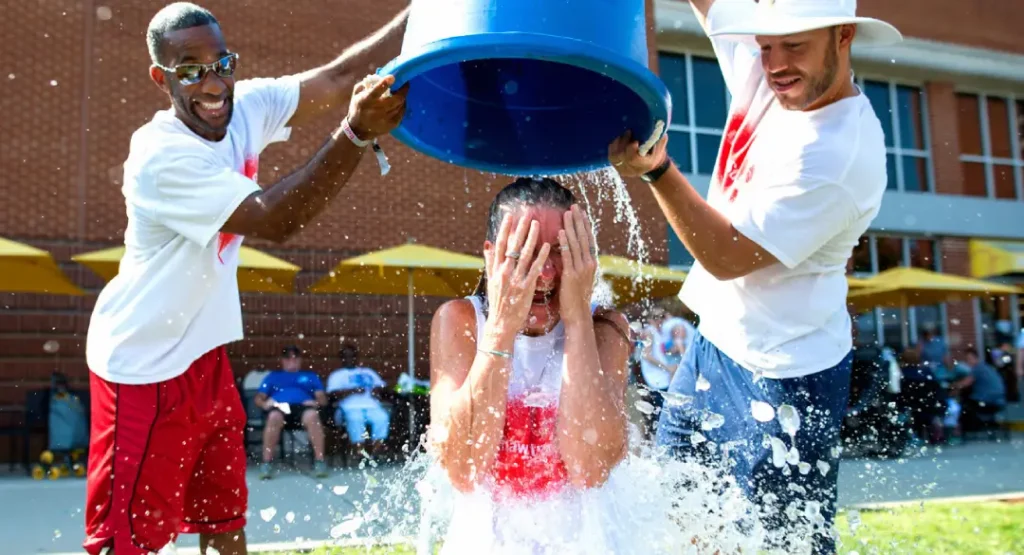Social Media Challenges: The Good, Bad and Dangerous
Viral internet trends are not a new concept for anyone with social feeds. Some are harmless, and there are harmful or even fatal ones. That’s why I’m asking myself, what is a “social media challenge”?
So in this vast guide, we will be unboxing everything – the psychology behind their rapid spread, some of the most famous social media challenges from now and then, and how to distinguish between innocent entertainment and something that can utterly destroy your life (or get you into serious trouble with the law).
You had better be prepared because it will get wild out here on this strange journey through the land of social media… dares!
Table of Contents
What Are Social Media Challenges?

In its simplest structure, social media challenges are internet tendencies that involve individuals recording themselves doing specific actions or events and posting videos on the web while nominating others to join.
They may be presented as stunts, pranks or other types of dares. Some can be characterised by creativity, while others can be foolish. However, their viral nature makes them unique, evidenced by the “challenge accepted” trend on social platforms.
Once they become popular enough to reach a tipping point where people cannot stop sharing these challenges anymore, they go wild like bushfire. This is because when many people repeatedly see similar clips in their feeds, it quickly becomes part of our culture, which everybody talks about even if they have not participated in any of them.
Origins
Although seeming so 21st century, there has always been an aspect of daring each other into doing silly or dangerous things since time immemorial, but let us not think too far back to those days when someone would say I dare you to jump off this wall. We did it without thinking twice, just for fun!
The Ice Bucket Challenge, which swept across the internet in 2014, is widely regarded as being the first major mass-participation viral campaign on social media. It aimed to raise funds and awareness for amyotrophic lateral sclerosis (ALS), also known as motor neuron disease.
Participants were required to film themselves soaked with ice-cold water and then challenge others to do likewise within 24 hours or donate money towards ALS research – relatively harmless. Still, it managed to collect more than $115 million!
Why Do They Go Viral? Understanding the Psychology
So, why do these tricks and videos attract global attention so obsessively? A few psychological factors are at play:
FOMO (Fear of Missing Out) People naturally tend to conform and not want to be left behind. Seeing celebrities, influencers, and even friends participating in something creates intense FOMO because you also want to be part of it.
Bandwagon Effect This is the theory that people tend to follow trends just because others are doing it. Posting Ice Bucket Challenge videos creates social pressure and herd mentality to join in when many people are doing it.
Belongingness There is a feeling of community and being part of something more significant when one takes up viral challenges. It makes us feel like we are connected with what’s happening around us globally on a larger scale.
Desire for excitement or adventure Some challenges can be dangerous, which appeal to our inherent need for thrill-seeking behaviour and pushing limits. One can imagine all those unexpected outcomes and infinite possibilities for getting famous overnight through social media virality.
Attention seeking Social media allows individuals to engage in self-promotion or seek attention from others. Those five minutes of fame on the internet can be exceptionally motivating.
The Most Iconic Viral Challenges

Now, let's examine some of the most famous and symbolic social media challenges over the years – those that rocked the internet and marked critical cultural events.
Cinnamon Challenge (2001)
Yes, the first-ever mega viral challenge goes back to the early noughties. People tried swallowing a spoonful of dry cinnamon without taking any liquids in less than 60 seconds.
This is much harder than it seems, leading to coughing fits, gasps for breath and a lot of mess. Doctors warned it could also cause choking, breathing problems and lung damage, though it did create some funny YouTube clips in its time. Oops!
Planking (2011)
This year, people had to lie face down with only their toes and forearms touching the ground in weird or dangerous places. It was harmless fun… until someone tried to ‘plank’ on a rail, up a tree or on top of a moving vehicle.
But as stunts got crazier to get those viral hits, injuries (and even deaths) quickly followed. Talk about risking life and limb for internet points!
Ice Bucket Challenge (2014)
As mentioned earlier, this was THE original social media challenge. Simple, fun and all for an incredible cause. It raised over 115 million dollars for the ALS Association and showed just how powerful the internet can be when used for good.
Tide Pod Challenge (2017)
Now we take another turn into darkness: inexplicably, teenagers started filming themselves biting into highly toxic laundry detergent Pods. Just for a few seconds of internet infamy!
This one sent shockwaves through Tide’s manufacturers and health authorities worldwide, who scrambled to tell people not to be so stupid. At least 86 cases were reported where teenagers were exposed, showing how terrifyingly influential online platforms can become.
Bird Box Challenge (2018)
Following on from the Netflix horror movie Bird Box – which saw people having to wear blindfolds to avoid seeing creatures that make them kill themselves – this saw people trying to do basic tasks while blindfolded. Getting dressed, driving a car (yes, really), walking into things… you name it.
A 17-year-old then crashed her car after driving while blindfolded, leading to outrage against this potentially lethal trend. Netflix even had to tell fans not to take part directly; it just shows how mad things were getting.
Milk Crate Challenge (2021)
Another physical stunt involves people attempting to scale wobbly pyramids made from plastic milk crates. It had the perfect mix of ridiculousness and high risk, becoming an international sensation almost overnight.
Footage showed people falling spectacularly from these unstable structures – sometimes from dizzying heights. Doctors reported broken bones, head injuries and even life-threatening falls as a result of this idiotic internet craze. Ouch!
The Positives: Using Viral Challenges For Good

For every dumb and dangerous challenge out there, you’ll find inspiring examples of using that viral reach to make the world a little bit better. These are the real winners:
The ALS Ice Bucket Challenge (2014)
As we discussed, this raised over $115 million for the ALS Association. It funded research to fight against that terrible disease. It was a challenge for an incredible, life-changing cause.
The 22 Push-Up Challenge (2016)
This one was for military veterans and their families. The aim was to raise awareness of veteran suicide rates. Dropping down and doing 22 push-ups got millions talking about the genuine mental health struggles many vets face on returning home. It's simple but super effective.
The Don’t Rush Challenge (2016)
Parents recorded videos of themselves going through the laborious process of getting multiple kids out of the car – all in a bid to tackle child vehicular heatstroke deaths—a reminder not to rush and risk leaving a sleeping child behind.
The Trashtag Challenge (2019)
Instead of stunts or pranks, people started posting before-and-after photos and videos of them… cleaning up litter from streets, beaches and public spaces. Communities came together in a positive, unifying way and helped clean the planet.
The #GraffitiHeart Challenge (2019)
People sprayed colourful hearts and messages of hope on walls around the world using a branded graffiti brush – in solidarity with a young Saudi person facing persecution for showing support for LGBTQ rights. It used that viral power to create a beautiful effect.
The Betty White Challenge (2022)
When beloved icon Betty White passed away aged 99, fans celebrated her legacy by encouraging people to donate to animal charities she loved so much. Over $800k was raised via the viral #BettyWhiteChallenge in her honour.
So yeah, some challenges make the world more positive! Who knew an internet craze could have such a meaningful real-life impact?
The Problem With Negative Or Harmful Challenges

Although not all viral challenges are harmless and well-intentioned, some are inconsiderate. They promote negative behaviour and do more harm than good.
Earlier, we discussed the Tide Pod Challenge of 2017 as a classic example. It is not only shocking to watch people bite into poisonous laundry detergent for the sake of becoming an internet sensation, but it is also hazardous. Many teenagers were exposed to severe injuries or even death because of this act. More than 80 cases were reported where young individuals came into contact with harmful chemicals in those pods.
Another example was the Bird Box challenge inspired by the Netflix horror movie. Unfortunately, such an idiotic idea led to a car crash by a 17-year-old girl who had to be hospitalised afterwards.
Perhaps the saddest among them is Blackout Challenge – an excruciating game designed for children under its influence whereby they strangle themselves till unconsciousness sets in to achieve short-lived euphoria moments.
Multiple deaths have been recorded over time, mostly involving young kids who died from suffocation after falling asleep during this event; one such incident happened early last year when a twelve-year-old boy was found passed out inside his bedroom, having tied something around his neck tight enough until he couldn’t breathe anymore. When it comes down to self-harm via digital platforms and advertising materials meant for vulnerable users, there’s no lower rock bottom.
The Legal & Physical Risks
Potentially fatal injuries aside, there are also severe legal risks that teens and internet users may not consider. Taking these challenges too far could land you with charges like:
- Reckless endangerment
- Public disorder offences
- Property damage
- Personal injury lawsuits from victims
Sharing or promoting the most extreme videos could encourage illegal activity in some jurisdictions. The authorities routinely plead with people not to glorify or engage in these harmful challenges for a good reason.
In 2018, a Utah man fatally killed someone by striking them with his truck while blindfolded as part of the Bird Box challenge. He was slapped with a hefty prison sentence for his utterly thoughtless, internet-fueled crime.
Beyond legal troubles, there's also the risk of physical or psychological trauma, bullying/peer pressure to participate in dangerous stunts, and developing normalisation around acts of self-harm. Not to mention possible permanent injury or disability resulting from these amateur stunts gone wrong.
Even seemingly “harmless” challenges like planking led to broken bones, concussions and spinal injuries when taken to reckless extremes for more clicks and shares. Is a moment of internet fame worth that?
Addictive, Toxic & Promoting Harmful Values
Digging deeper, I see many challenges promoting worryingly addictive behaviour by striving for constant viral renewal and social media clout. That mindless pursuit of likes, shares, and views at all costs isn't a positive mindset to foster.
Some argue that they promote unhealthy values around risk-taking, rebellion against authority, self-destructive tendencies and anti-social behaviour: Bravado, machismo and one-upmanship over responsible actions.
There are also issues around informed consent. How many challenge participants truly understand the risks? How many are coerced or manipulated into taking part in peer pressure? It's not hard to imagine bullying situations where people are goaded into harming themselves to avoid being socially rejected.
This brings us to a concern about the gender divide. Studies show males are more likely to participate in dangerous stunts, while females tend toward more benign challenges involving dance moves or aesthetics. Outdated but toxic social pressures toward masculinity could be one factor at play.
Fundamentally, a lot of the most problematic challenges have an undercurrent of people seeking violence, shock value or self-harm as a way of acting out or releasing emotions. They are not precisely healthy outlets for those feelings.
The Role Of Social Media Platforms & The Fine Line

The leading players in the social media industry have a massive responsibility to spread viral challenges and stop dangerous fads. However, they must balance safeguarding their users and limiting free speech.
Most platforms delete content that promotes illegal activities or endangers people's lives. Furthermore, some takedown harmful challenge content when it appears.
However, their detractors think these firms react only after events unfold and that their algorithms for machine learning even aid in intensifying sensational acts to increase user engagement and advertising metrics.
Things got out of hand in 2022 when Snapchat and TikTok allowed the traumatic Milk Crate Challenge to spread with little regulation, resulting in many people getting injured. Lawsuits were filed against them for negligently allowing this viral trend to grow uncontrollably.
It’s a thin line between censorship and harm minimisation. Going too far may infringe upon freedom of speech, while failure to act promptly lets false information circulate widely, along with poisonous challenges, before it can be stopped.
Parental & Education Roles
A huge part of combating harmful social media challenges is better education – both children/teens on the real-life dangers and parents/teachers on staying ahead of the trends.
Schools are now incorporating specific lessons to warn students about the risks of challenges going viral. Open discussions explore responsible social media participation and the potential consequences of thrill-seeking gone too far.
Meanwhile, parents are urged to stay clued up on emerging trends, monitor their kids' activity online, and create an environment for honest conversations away from peer pressure. Promoting emotional resilience against following the crowd is critical.
By raising awareness, facilitating dialogue and cultivating critical thinking skills, vulnerable groups can develop healthier coping mechanisms beyond self-destructive gratification via likes and shares.
Finding The Right Balance: Leveraging Social Media's Positive Potential
So, where do we go from here? There are significant issues around toxic, harmful online challenges that need addressing. And social platforms should be doing more to limit the spread of the most high-risk, law-breaking content.
But an outright ban or overly draconian censorship isn't the answer either. Social media has immense potential for viral positivity, too – just look at all those heartwarming, socially-conscious examples shared earlier.
The secret is finding that equilibrium where we celebrate fun, uplifting challenges that bring out the best in people… while firmly rejecting those that recklessly promote harm, hatred or illegal behaviour.
We need the major platforms' algorithms to uplift messages of hope and causes that improve the world. To let good inevitably outweigh the bad by not giving oxygen to toxic stunts. They are combined with media literacy so people can think critically about what they're mimicking.
Because virality and social media challenges aren't inherently a negative phenomenon. They're simply a reflection of modern society.
And society's dark impulses don't have to define the experience. Not when that same collective momentum could be channelled into something beautiful that unites us for the greater good.
Challenges that get people volunteering for charities. That encourages acts of kindness and community service. That uses people's power to clean the environment or campaign for positive change.
That's a social media dare I'd be honoured to accept! Who's joining me?
FAQs
When did the social media challenge start?
2014, the Ice Bucket Challenge became the first widespread social media phenomenon. It raised over $115 million for ALS research and is still one of the most successful challenges.
Why are these challenges so contagious?
Some psychological factors that contribute to challenging popularity include fear of missing out (FOMO), herd mentality, desire for belongingness, thrill-seeking behaviour and attention-seeking tendencies.
Which viral challenges have been iconic?
The Cinnamon Challenge in 2001, Planking in 2011, Ice Bucket Challenge in 2014 (again), and Tide Pod and Bird Box challenges in 2019 were all major viral crazes. In addition, the Milk Crate Challenge was popularised on social media in 2021.
Has any positive cause ever been associated with a social media challenge?
Yes – many have helped raise awareness or funds for veterans’ mental health care, ALS research, child vehicular safety, environmental cleanup efforts, LGBTQ+ rights advocacy and more.
What are some risks posed by dangerous or harmful challenges?
There have been instances where people got hurt badly because they did dumb stuff during these things, like hurting themselves intentionally or doing illegal activities at someone else’s behest.
What should social media companies do?
They should remove posts featuring illegal stunts or apparent dangers that could result in harm – but let us still say whatever we want (according to critics).
How can toxic challenges be stopped?
To prevent unthinkingly mimicking self-destructive fads among young people: teach better at schools; talk more openly with parents/teachers about this sort of thing; build kids’ emotional backbone – yeah!
